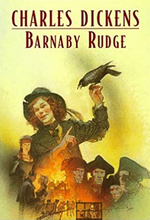Home > Dickens > THE 15 NOVELS OF CHARLES DICKENS ON THIS SITE > "Barnaby Rudge" (1841) by Charles Dickens
 "Barnaby Rudge" (1841) by Charles Dickens
"Barnaby Rudge" (1841) by Charles Dickens
Sunday 28 February 2021, by
Dickens’s first historical novel, set in the period of the ultra-violent anti-catholic Gordon Riots in the London of 1780 that saw angry mobs storm into the Parliament buildings, destroy the central Newgate prison and other buildings and shake the state to its very foundations.
The historical novel genre, the untopical subject matter and the unusual simple-minded central figure of the title perhaps explain. at least partially, the public’s initial rejection of the book [1], which has remained one of his least-known works.
However, the villains, and there are several main ones, are really strikingly portrayed, the story is dramatic in the extreme (although the first 200 pages are calm, albeit as charming as anything Dickens ever wrote), the central character, the easily-led-astray Barnaby, with his ever-so-clever raven Grip always at his side, is an unusually interesting personality, the historical events are astounding — England came close to having its own Bastille Day nine years before the French had theirs — and dramatically portrayed, and, unusually for Dickens, the pace and intensity carry on full-blast right up to the end. Last but not least, there’s the "beautiful, bewitching, captivating Dolly" Varden.
The author’s own comments on the novel in his (quite marvelous) Prefix, included below, cast light on his motivations in adventuring into the historical-novel genre, and are not without relevance to our own times:
“ No account of the Gordon Riots having been to my knowledge introduced into any Work of Fiction, and the subject presenting very extraordinary and remarkable features, I was led to project this Tale.
It is unnecessary to say, that those shameful tumults, while they reflect indelible disgrace upon the time in which they occurred, and all who had act or part in them, teach a good lesson. That what we falsely call a religious cry is easily raised by men who have no religion, and who in their daily practice set at nought the commonest principles of right and wrong; that it is begotten of intolerance and persecution; that it is senseless, besotted, inveterate and unmerciful; all History teaches us. But perhaps we do not know it in our hearts too well, to profit by even so humble an example as the ‘No Popery’ riots of Seventeen Hundred and Eighty. „
Barnaby Rudge was printed in 42 weekly instalments in Dickens’s own magazine Master Humphrey’s Clock between February 1841 and November 1841, with the considerable total of 85 illustrations — by far the most in any of Dickens’s novels — of which 68 were done by Hablot Browne (Phiz) and 17 by George Cattermole.
All of these elaborate and often extremely dramatic captioned illustrations [2] are included here.
(254,000 words)
An e-book, with the illustrations, is available for downloading below.
Barnaby Rudge (e-book)
[1] as well as the reading public’s outspoken dissatisfaction at the sorrowful end of its enormously-popular heroine Little Nell in his previous novel, The Old Curiosity Shop, that led many of his readers to boycott his following books.
[2] the captions of the illustrations did not appear in the original Master Humphrey’s Clock editions, and were not composed by Dickens or the illustrators, but by later editors.